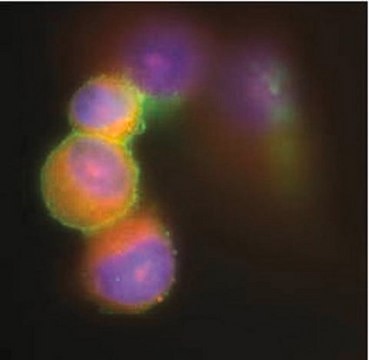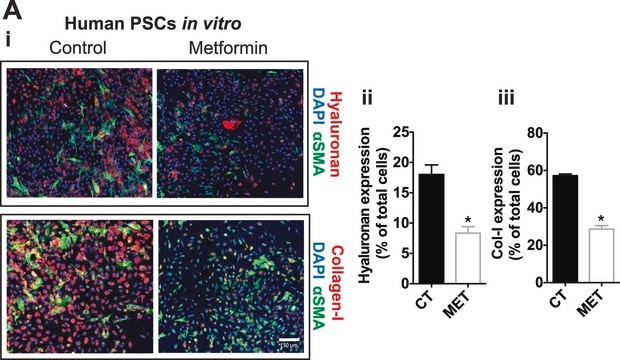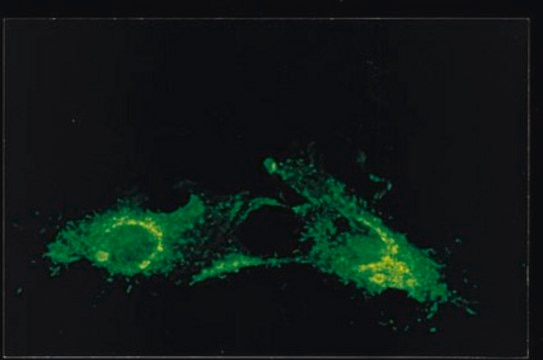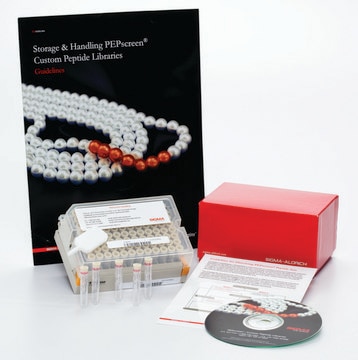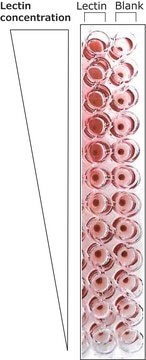MAB8599
Anti-RSV Antibody, fusion protein, all type A, B strains, clone 131-2A
clone 131-2A, Chemicon®, from mouse
Synonym(s):
RSV Fusion
Sign Into View Organizational & Contract Pricing
All Photos(1)
About This Item
UNSPSC Code:
12352203
eCl@ss:
32160702
NACRES:
NA.41
Recommended Products
biological source
mouse
Quality Level
antibody form
purified immunoglobulin
antibody product type
primary antibodies
clone
131-2A, monoclonal
species reactivity
human
manufacturer/tradename
Chemicon®
technique(s)
ELISA: suitable
flow cytometry: suitable
immunofluorescence: suitable
western blot: suitable
isotype
IgG2aκ
shipped in
wet ice
General description
RSV is a labile paramyxovirus that produces a characteristic fusion of human cells in tissue culture--the syncytial effect. Two subtypes, A and B, have been identified. Subtype B are characterized as the asymptomatic strains of the virus. The more severe clinical illnesses involve Subtype A strains.
Specificity
Reacts with RSV fusion protein, specifically epitope F1a of RSV F-protein {Sominina AA, et al Vestn Ross Akad Med Nauk. 1995;(9):49-54} found on all A & B strains of RSV.
Immunogen
A2 RSV virus cell extract
Epitope: all type A & B strains
Application
Anti-RSV Antibody, fusion protein, all type A, B strains, clone 131-2A detects level of Respiratory Syncytial Virus & has been published & validated for use in ELISA, FC, IF & WB.
Indirect immunofluorescence.
ELISA
Immunoblotting: (using purified F protein preparations, clone identified a ~70kDa band, Tripp, RA et al 2003)
Final working dilutions must be determined by end user.
ELISA
Immunoblotting: (using purified F protein preparations, clone identified a ~70kDa band, Tripp, RA et al 2003)
Final working dilutions must be determined by end user.
Research Category
Infectious Diseases
Infectious Diseases
Research Sub Category
Infectious Diseases - Viral
Infectious Diseases - Viral
Target description
~70 kDa
Physical form
Format: Purified
Protein A Purified immunoglobulin in 0.02M phosphate, 0.25M NaCl, 0.1% NaN3 pH 7.6
Protein A purified
Storage and Stability
Maintain for 1 year at 2–8°C from date of shipment. Aliquot to avoid repeated freezing and thawing. For maximum recovery of product, centrifuge the original vial after thawing and prior to removing the cap.
Analysis Note
Control
RSV Control Slides, Catalogue Number 5012-5
RSV Control Slides, Catalogue Number 5012-5
Other Notes
Concentration: Please refer to the Certificate of Analysis for the lot-specific concentration.
Legal Information
CHEMICON is a registered trademark of Merck KGaA, Darmstadt, Germany
Disclaimer
Unless otherwise stated in our catalog or other company documentation accompanying the product(s), our products are intended for research use only and are not to be used for any other purpose, which includes but is not limited to, unauthorized commercial uses, in vitro diagnostic uses, ex vivo or in vivo therapeutic uses or any type of consumption or application to humans or animals.
Not finding the right product?
Try our Product Selector Tool.
recommended
wgk_germany
WGK 2
flash_point_f
Not applicable
flash_point_c
Not applicable
Certificates of Analysis (COA)
Search for Certificates of Analysis (COA) by entering the products Lot/Batch Number. Lot and Batch Numbers can be found on a product’s label following the words ‘Lot’ or ‘Batch’.
Already Own This Product?
Find documentation for the products that you have recently purchased in the Document Library.
L M Haynes et al.
Journal of virology, 75(22), 10730-10737 (2001-10-17)
The mammalian Toll-like receptor 4, TLR4, is an important component in the innate immune response to gram-negative bacterial infection. The role of TLR4 in antiviral immunity has been largely unexplored. In this study, the in vivo immune responses to respiratory
Anti-G protein antibody responses to respiratory syncytial virus infection or vaccination are associated with inhibition of G protein CX3C-CX3CR1 binding and leukocyte chemotaxis
Harcourt, Jennifer L, et al
The Journal of Infectious Diseases, 190, 1936-1940 (2004)
Patricia Clua et al.
Cells, 9(7) (2020-07-15)
The nasal priming with nonviable Lactobacillus rhamnosus CRL1505 (NV1505) or its purified peptidoglycan (PG1505) differentially modulates the respiratory innate immune response in infant mice, improving their resistance to primary respiratory syncytial virus (RSV) infection and secondary pneumococcal pneumonia. In association
R A Tripp et al.
Journal of virology, 73(9), 7099-7107 (1999-08-10)
BALB/c mice sensitized to vaccinia virus expressed G protein of respiratory syncytial virus (RSV) develop a Th2-type cytokine response and pulmonary eosinophilia when challenged with live RSV. In this study, BALB/c mice were immunized or challenged with an RSV mutant
Subgrouping of respiratory syncytial virus strains from Australia and Papua New Guinea by biological and antigenic characteristics
Hierholzer, J C, et al
Archives of Virology, 136, 133-147 (1994)
Our team of scientists has experience in all areas of research including Life Science, Material Science, Chemical Synthesis, Chromatography, Analytical and many others.
Contact Technical Service
